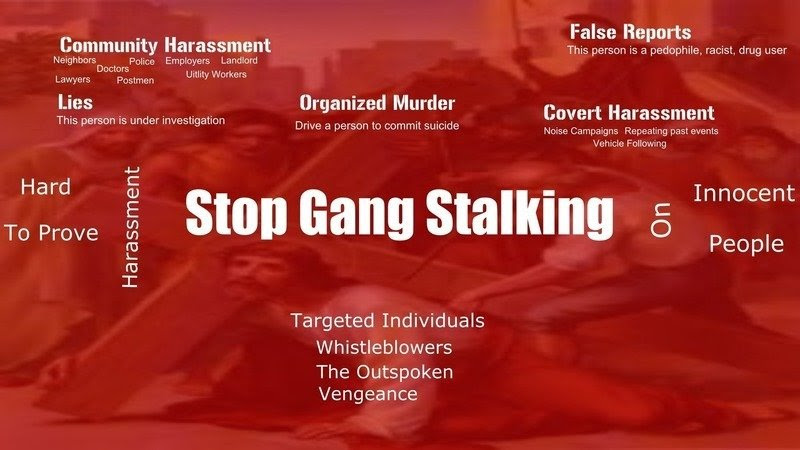The Phenomenology of Group Stalking (‘Gang-Stalking’): A ...
The Phenomenology of Group Stalking (‘Gang-Stalking’): A Content Analysis of Subjective Experiences
1. Introduction
Stalking denotes a pattern of repeated, unwanted intrusion by one person into the life of another in a manner that causes distress, disruption, or fear [1,2]. The concept of stalking was introduced in the late 1980s to describe a form of interpersonal aggression that, although common through the ages, had come to be socially unacceptable in the western world after the recognition of equal rights for women and the prosecution of domestic violence. To that extent, stalking is a social construct that arose in a particular social and cultural context [3].
Since the turn of the millennium, another term linked to stalking has gained currency in the media and on the world wide web—that of ‘group’ or ‘gang’ stalking. Stalking generally involves a single stalker who may occasionally recruit others into stalking by proxy, their involvement usually being unwitting [4]. By contrast, reports of group or gang-stalking describe stalking by multiple individuals who engage in a shared endeavour with a group purpose. For research purposes, the number is taken as three or more, although in many instances those suffering from the phenomenon have reported the involvement of far greater numbers [5].
Despite the experience of gang-stalking being so widely reported and the evidence of its harmful effects on individuals and on society at large, there is a dearth of research into its nature and into the components that constitute the experience. Sheridan and James’ study [5] appears to be the only one to have investigated this central feature of this subject. As with most studies of victim experiences, their study was based upon questionnaire data from self-selected respondents.
3. Results
3.1. Length of Stalking
None of the writers of the narratives described their experiences as having ended. All 50 authors stated or implied that they had been gang stalked for lengthy periods of time (e.g., one mentioned being seen by seven psychologists during the period of being targeted, another described having been targeted whilst living in three different countries). The shortest case was described as having begun “in the last few months” and the longest as continuing for “more than 22 years”.
3.2. Reasons for the Gang-Stalking
The narratives were examined to establish whether the perceived reasons for being targeted by gang stalkers could be identified. Reasons were found in 20 of the 50 accounts. In all 20 cases, no named person was believed to be targeting the victim. Representative examples of the reasons given for the gang-stalking were as follows:
“Why? To drive people to meet-up groups or a psychiatrist so they can be medicated and/or get more federal grants for more mental health instead of training a real police force. Post Traumatic Stress Disorder is a big seller in the area.”
“It is a brainwashing military experiment. Post 9/11, they isolate certain people to stop them acting against government.”
“It is part of an overt agenda to create and test mind control. They are creating weaponry tested on us.”
“I began driving a friend around to make his pot sales and I started noticing we would get tailed from time to time. I knew this friend had connects in weird places (he knows members of Anonymous, he knows people who work at the Pentagon). I also did a lot of research and was very vocal about being anti-government and anti-corporation. This is what got me targeted. If you are vocal about your positions, then you will eventually run across a civilian spy who will pass the information to their superiors, who will continue to pass the information up the chain of command. Once you’re on their list, your life can become a living hell.”
5. Conclusions
The experience of being gang-stalked appears to be a widespread phenomenon that has been subject to little scientific examination. The current study provides a preliminary description of the phenomena involved that was produced by a methodology that did not incorporate pre-conceived assumptions. This provides a foundation upon which further research could be built. It also serves to confirm the harmful effects of the gang-stalking experience upon sufferers, first set out in the only other study available [5]. These findings constitute a potent reason why gang-stalking should be regarded as an important subject for study.
Whilst it was important to adopt a methodology that allowed the phenomena constituting the experience of gang-stalking to emerge de novo, it would now be appropriate to conduct studies of cases based upon specific questions in order to gain a clearer idea of the proportion of sufferers who experience each category of phenomenon, as the main categories have now been elucidated and the core phenomena described. This is because higher proportions are likely to be elicited through direct questioning than were found by studying internet descriptions. Finally, whilst this study has described the core phenomena of the gang-stalking experience, the question remains as to whether gang-stalking is a single phenomenon or represents several overlapping phenomena, each with its own defining pattern of experiences.
Social Semiotics of Gangstalking Evidence Videos on ...
Social Semiotics of Gangstalking Evidence Videos on YouTube: Multimodal Discourse Analysis of a Novel Persecutory Belief System
 #1 Gavin Brookes, PhD,#2 and Daniel Hunt, PhD#3
#1 Gavin Brookes, PhD,#2 and Daniel Hunt, PhD#3Abstract
Background
Gangstalking
refers to a novel persecutory belief system wherein sufferers believe
that they are being followed, watched, and harassed by a vast network of
people in their community who have been recruited as complicit
perpetrators. They are frequently diagnosed as mentally ill, although
they reject this formulation. Those affected by this belief system
self-identify as targeted individuals (TIs). They seek to prove the
veracity of their persecution and dispute the notion that they are
mentally ill by posting videos online that purport to provide evidence
of their claims.
Introduction
Gangstalking refers to a persecutory belief system wherein those affected believe they are being followed, watched, and harassed by many people in their community who have been recruited into a network of complicit perpetrators [1]. In contrast to traditional forms of stalking that are usually organized by a single person [2], sufferers of gangstalking are unable to identify a responsible individual and experience it as a widely distributed and coordinated effort of co-conspirators.
Those affected gather in online communities to support each other and co-construct, develop, and contest the gangstalking belief system. The community members use a specialized lexicon to describe their experiences and to signal membership in the community of those affected. For example, the term “gangstalking” is used to describe the system of persecution, a “targeted individual (TI)” denotes the subject of the harassment, while those who participate in the intimidation are known as “perpetrators” or “perps” [3].
People affected by gangstalking report that the experience is extremely distressing. The campaign of harassment is frequently experienced as the accumulation of numerous otherwise innocuous acts, such as people clearing their throat, muttering under their breath, or giving lingering glances as they pass on the street. Because each of these acts may individually be passed off as unremarkable and mundane, TIs find it difficult to prove the existence of the harassment. When they come to clinical attention, they are frequently diagnosed with psychiatric illness and their belief systems are labeled as persecutory delusions [4]. However, TIs interpret such diagnoses as part of a gangstalking plan; by making them appear mentally ill, they are further discredited and stigmatized.
Our previous work found that concerns about being believed and procuring and presenting proof of their systematic victimization are prime concerns of TIs in online fora [3]Discussion
Clinical Implications
This observation may have important clinical ramifications. Traditionally, psychiatrists define delusions as fixed beliefs that are not amenable to change, considering conflicting evidence [47]. An alternative definition is that delusions are beliefs that are demonstrably untrue or not shared by others [48]. However, these and other definitions of delusions fall short, and arriving at a definitive definition may be impossible [49]. The prospect of a clinician definitively establishing the truth or falsity of a delusional belief system is often impractical or impossible. Often when a clinician states that a belief system is untrue or impossible, they are relying on their own beliefs, biases, and cultural referents. By shifting, instead, to a linguistic or semiotic understanding of delusions as belief systems that are unresolvable or that defer understanding ad infinitum, clinicians may sidestep the difficulties inherent in existing definitions. Ultimately, all users of semiotic systems—patients and clinicians alike—are subject to the same fundamental limits on communication and understanding inherent in language and all symbolic systems. Such a humbling realization may help to promote empathy and understanding and reduce stigma affecting people afflicted by persecutory belief systems.
Conclusions
These data provide insight into a novel persecutory belief system. Interpersonal concerns are important for people affected, and they construe others as either sympathetic or hostile. They create positive ambient affiliation with viewers. We found that vloggers use multimodal deixis to illustrate the salience of the belief system. The videos highlighted the Derridean concept of différance, wherein the meaning of polysemous signifiers is deferred without definitive resolution. This may be important in communicating with people and patients with persecutory belief systems. Clinicians may consider stepping away from the traditional true/false dichotomy endorsed by psychiatric classification systems and focus on the ambiguity in semiotic systems generally and in persecutory belief systems specifically.
Linguistic Analysis of Online Communication About a Novel ...
Linguistic Analysis of Online Communication About a Novel Persecutory Belief System (Gangstalking): Mixed Methods Study
- PMID: 33666560
- PMCID: PMC7980115
- DOI: 10.2196/25722
Abstract
Background: Gangstalking is a novel persecutory belief system whereby those affected believe they are being followed, stalked, and harassed by a large number of people, often numbering in the thousands. The harassment is experienced as an accretion of innumerable individually benign acts such as people clearing their throat, muttering under their breath, or giving dirty looks as they pass on the street. Individuals affected by this belief system congregate in online fora to seek support, share experiences, and interact with other like-minded individuals. Such people identify themselves as targeted individuals.
Objective: The objective of the study was to characterize the linguistic and rhetorical practices used by contributors to the gangstalking forum to construct, develop, and contest the gangstalking belief system.
Results: The gangstalking forum served as a site of discursive contest between 2 opposing worldviews. One is that gangstalking is a widespread, insidious, and centrally coordinated system of persecution employing community members, figures of authority, and state actors. This was the dominant discourse in the study corpus. The opposing view is a medicalized discourse supporting gangstalking as a form of mental disorder. Contributors used linguistic practices such as presupposition, nominalization, and the use of specialized jargon to construct gangstalking as real and external to the individual affected. Although contributors generally rejected the notion that they were affected by mental disorder, in some instances, they did label others in the forum as impacted/affected by mental illness if their accounts if their accounts were deemed to be too extreme or bizarre. Those affected demonstrated a concern with accumulating evidence to prove their position to incredulous others.
Conclusions: The study found that contributors to the study corpus accomplished a number of tasks. They used linguistic practices to co-construct an internally coherent and systematized persecutory belief system. They advanced a position that gangstalking is real and contested the medicalizing discourse that gangstalking is a form of mental disorder. They supported one another by sharing similar experiences and providing encouragement and advice. Finally, they commiserated over the challenges of proving the existence of gangstalking.
Keywords:
computer mediated communication; corpus linguistics; delusions;
discourse analysis; eHealth; internet; language; linguistics; online
discourse; psychosis; schizophrenia.




